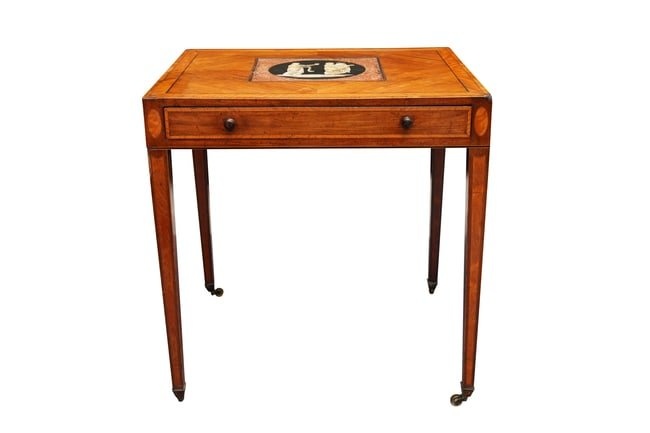A GEORGE III SHERATON STYLE MAHOGANY, SATINWOOD CROSS BANDED AND SCAGLIOLA INLAID SIDE TABLE
A GEORGE III SHERATON STYLE MAHOGANY, SATINWOOD CROSS BANDED AND SCAGLIOLA INLAID SIDE TABLE, CIRCA 1785, the quarter veneered rectangular top centered with an inlaid panel depicting classical figures above a frieze drawer and raised on square section tapered legs and brass castors.
72cm high x 69cm wide x 59cm deep
Notes: The plaque in the centre of the table is in Scaglioa which is made from selenite, a crystalised or foliated sulphate of lime, reduced to a friable condition by heat. It is then ground to a very fine powder, mixed with colouring matter and worked into a paste that can be rolled into slabs of any shape or size. Originally it was used to simulate marble, mainly in walls and columns. In the 18th century, by combining it with different colours, it was used to imitate inlays of pietra dura (Florentine mosaic). By the 1740s Florence was the most famous centre for scagliola work.
Provenance: From a collection of furniture and antiques left to the Society for the Protection of Ancient Buildings (SPAB ) in 1939 by Evelyn Stannus of Kensington. Items in the collection are believed to have come from Ireland. Since 1939 many objects from the collection have been on loan to the National Trust and this item has been displayed at the Peckover Estate.
72cm high x 69cm wide x 59cm deep
Sale price
Estimate
Reserve
Time, Location
Auction House
A GEORGE III SHERATON STYLE MAHOGANY, SATINWOOD CROSS BANDED AND SCAGLIOLA INLAID SIDE TABLE, CIRCA 1785, the quarter veneered rectangular top centered with an inlaid panel depicting classical figures above a frieze drawer and raised on square section tapered legs and brass castors.
72cm high x 69cm wide x 59cm deep
Notes: The plaque in the centre of the table is in Scaglioa which is made from selenite, a crystalised or foliated sulphate of lime, reduced to a friable condition by heat. It is then ground to a very fine powder, mixed with colouring matter and worked into a paste that can be rolled into slabs of any shape or size. Originally it was used to simulate marble, mainly in walls and columns. In the 18th century, by combining it with different colours, it was used to imitate inlays of pietra dura (Florentine mosaic). By the 1740s Florence was the most famous centre for scagliola work.
Provenance: From a collection of furniture and antiques left to the Society for the Protection of Ancient Buildings (SPAB ) in 1939 by Evelyn Stannus of Kensington. Items in the collection are believed to have come from Ireland. Since 1939 many objects from the collection have been on loan to the National Trust and this item has been displayed at the Peckover Estate.
72cm high x 69cm wide x 59cm deep



